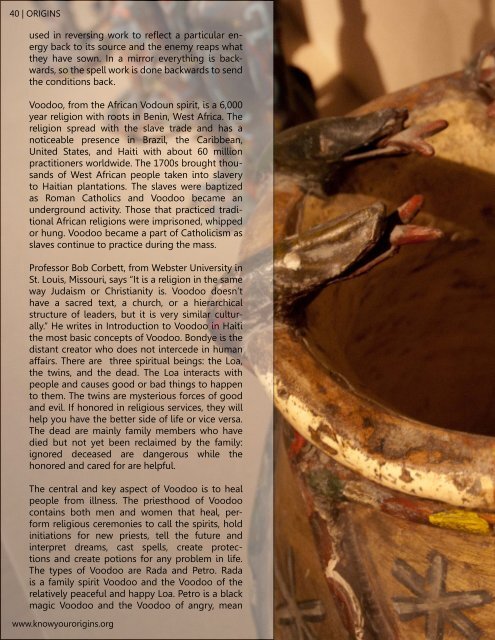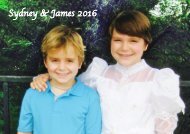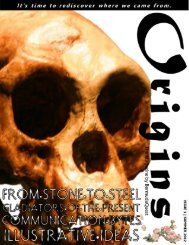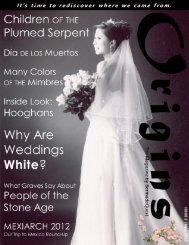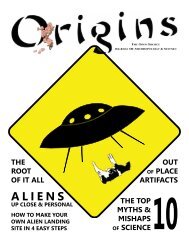Issue 6: Curanderismo, Folk Healing & Traditional Medicine
Throughout generations, people cure ailments through chants, specific lifestyles, local herbs, and more. Today, pharmaceuticals have taken priority over traditional remedies. For this fall's issue we're going to focus on looking back at these other remedies and the pros and cons of modern practices. As always, we strive to relate the past and present and show the good and bad sides of both.
Throughout generations, people cure ailments through chants, specific lifestyles, local herbs, and more. Today, pharmaceuticals have taken priority over traditional remedies. For this fall's issue we're going to focus on looking back at these other remedies and the pros and cons of modern practices. As always, we strive to relate the past and present and show the good and bad sides of both.
Create successful ePaper yourself
Turn your PDF publications into a flip-book with our unique Google optimized e-Paper software.
40 | ORIGINS<br />
used in reversing work to reflect a particular energy<br />
back to its source and the enemy reaps what<br />
they have sown. In a mirror everything is backwards,<br />
so the spell work is done backwards to send<br />
the conditions back.<br />
Voodoo, from the African Vodoun spirit, is a 6,000<br />
year religion with roots in Benin, West Africa. The<br />
religion spread with the slave trade and has a<br />
noticeable presence in Brazil, the Caribbean,<br />
United States, and Haiti with about 60 million<br />
practitioners worldwide. The 1700s brought thousands<br />
of West African people taken into slavery<br />
to Haitian plantations. The slaves were baptized<br />
as Roman Catholics and Voodoo became an<br />
underground activity. Those that practiced traditional<br />
African religions were imprisoned, whipped<br />
or hung. Voodoo became a part of Catholicism as<br />
slaves continue to practice during the mass.<br />
Professor Bob Corbett, from Webster University in<br />
St. Louis, Missouri, says “It is a religion in the same<br />
way Judaism or Christianity is. Voodoo doesn’t<br />
have a sacred text, a church, or a hierarchical<br />
structure of leaders, but it is very similar culturally.”<br />
He writes in Introduction to Voodoo in Haiti<br />
the most basic concepts of Voodoo. Bondye is the<br />
distant creator who does not intercede in human<br />
affairs. There are three spiritual beings: the Loa,<br />
the twins, and the dead. The Loa interacts with<br />
people and causes good or bad things to happen<br />
to them. The twins are mysterious forces of good<br />
and evil. If honored in religious services, they will<br />
help you have the better side of life or vice versa.<br />
The dead are mainly family members who have<br />
died but not yet been reclaimed by the family:<br />
ignored deceased are dangerous while the<br />
honored and cared for are helpful.<br />
The central and key aspect of Voodoo is to heal<br />
people from illness. The priesthood of Voodoo<br />
contains both men and women that heal, perform<br />
religious ceremonies to call the spirits, hold<br />
initiations for new priests, tell the future and<br />
interpret dreams, cast spells, create protections<br />
and create potions for any problem in life.<br />
The types of Voodoo are Rada and Petro. Rada<br />
is a family spirit Voodoo and the Voodoo of the<br />
relatively peaceful and happy Loa. Petro is a black<br />
magic Voodoo and the Voodoo of angry, mean<br />
www.knowyourorigins.org


